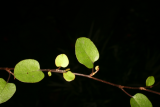Additional notes (click to expand)
Commemorative
Muehlenbeckia complexa, the aptly named Creeping Wire Vine, commemorates Dr Heinrich
Gustav Muehlenbeck or Mühlenbeck (1798–1845), a physician from Mulhouse, France, who
investigated the flora of Alsace. He wrote on potato diseases Maladie des pommes de terre –
krankheit der kartoffeln (in French and German, 1845). His vast herbarium, the Herbier Muehlenbeck, which consists of tens of thousands of specimens classifi ed using the system of AP De Candolle (1824–74), has been deposited in the Louis Pasteur Herbarium of Strasbourg by the Société Industrielle de Mulhouse. A full catalogue has not been made, suffice it to say that it
contains 20 plant families and 250 genera beginning with ‘A’. Carl Daniel Friedrich Mieissner (1800–74), professor of botany at the University of Basel, just across the border from Mulhouse,
named Muehlenbeckia after his contemporary and neighbour in 1841. Meissner was prolific in his publication of Australian genera, but neither he nor Muehlenbeck appear to have visited Australia or New Zealand.
Oakeley, Dr. Henry. (2012). Doctors in the Medicinal Garden. Plants named after physicians. Royal College of Physicians.
link
Horticulture
Muehlenbeckia complexa belongs to the family Polygonaceae and grows naturally in New Zealand in damp, fertile soils. In the Medicinal Garden, its creeping stems and miniature dark-green leaves make it an effective spreading ground cover in partially shaded borders. We only grow M. complexa var triloba with unusual violin-shaped leaves. It is trimmed as required to prevent it smothering neighbouring plants. Frost hardy, it benefits from an annual mulching with bark chips as protection. (Clare Beacham)
Oakeley, Dr. Henry. (2012). Doctors in the Medicinal Garden. Plants named after physicians. Royal College of Physicians.
link
Other use
This tangled creeper from New Zealand was the food for the moas, giant flightless birds, which were eaten into extinction by the indigenous peoples, aided by later settlers, thus upsetting any myth of living in harmony with nature. In South America, M. sagittifolia was used in the 19th century as a treatment for syphilis and liver abscesses (Hieronymus, 1882).
Oakeley, Dr. Henry. (2012). Doctors in the Medicinal Garden. Plants named after physicians. Royal College of Physicians.
link
Sweet, juicy edible fruits.
Geographical distribution
- Australasia, New Zealand, New Zealand North
- Australasia, New Zealand, New Zealand South
Muehlenbeckia axillaris (Hook. f.) Walp.
Family: POLYGONACEAEGenus: Muehlenbeckia
Species: axillaris (Hook. f.) Walp.
Common names: Sprawling wirevine; Australian ivy
Distribution summary: Australasia
Habit: Shrub
Hardiness: H6 - Hardy; very cold winter
Habitat: Rocky slopes
Garden status: Currently grown
Garden location: Southern Hemisphere (K)
Flowering months: July
Reason for growing: Commemorative, other use



